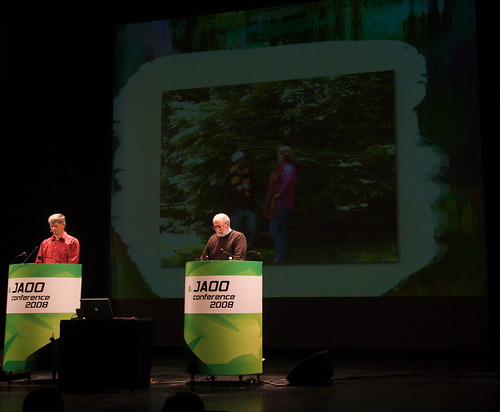dConstructing Augmented Reality
Thu 08 September 2011 by Jim PurbrickOne of the events that kicked off Brighton Digital Festival was dConstruct, the always thought provoking conference run by clearleft.
As usual I found most of the sessions interesting, but not always relevant as there’s a heavy design rather than development focus. The most relevant talk this year was Kevin Slavin’s final talk, Reality is Plenty, which argued that augmented reality is not the next big thing, just as it wasn’t in 2005.
Despite Kevin having a dig at Second Life and having spent a lot of time working on Augmented Reality with Blast Theory while at Nottingham University, I mostly agreed. While there are definitely use cases which benefit from augmented reality (fighter pilot navigation systems and things like Carbon Goggles which are all about making invisible aspects of objects visible) and virtual reality (simulation and virtual meeting spaces) there are plenty of others which are better served by other interfaces. Environments like Second Life are particularly exciting as they allow people to quickly prototype systems to discover which applications work and which don’t.
With both AR and VR it’s tempting to argue that they allow for intuitive interfaces as they model or overlay the real world: people know how to navigate a 3D space so they know how to use a 3D environment and they know how to use AR as they can see. Anyone who has done their time climbing the Second Life learning curve or trying to use AR to find their way around will know this clearly isn’t true. Apparently more abstract interfaces like maps, which talk to the mind rather than the senses are often much easier to use.
There’s a lot of work to be done to make both AR and VR as easy to use as 2D interfaces, let alone as natural as using real world senses. Now that the huge technical problems around networking virtual environments and tracking real world objects with mobile devices are starting to be solved, it is mostly UI work that needs to be done to make these technologies more widely used.
Even if the UX issues are solved there will still be many cases where speaking to the mind is much better than speaking to the senses.
Meaningful Choices
On Friday I jumped on the train to London to attend Playful 2010, a one day conference put on by mudlark of World of Love fame. Despite billing itself as a day of cross “disciplinary frolicking” and featuring designers, podcasts, discussions of narrative, iphone augmented paper games and Disco Snake …
read moreLike Second Life
Was without a doubt the phrase I heard most often yesterday, especially if you include variants like “Not Like Second Life”, “A bit like Second Life” and “Unlike Second Life”. Whatever else it’s achieved, Second Life has definitely become the frame of reference for the small and somewhat myopic …
read moreAnything But Java
Last week I was invited to talk at JAOO Denmark. Originally a Java conference, JAOO is now a very broad software development conference covering everything from agile to language design to distributed systems.
The stand out talk on the first day was Gregor Hohpe‘s Programming the Cloud which enumerated …
read moreJon Blow
At the recommendation of John and Alice I took a break from Develop Online to listen to Jon Blow‘s talk at Games:Edu this week and was totally blown away.
Jon talked about whether games are poised to enter a golden age similar to films in the ‘30s, when …
read more The Creation Engine No. 2
The Creation Engine No. 2

